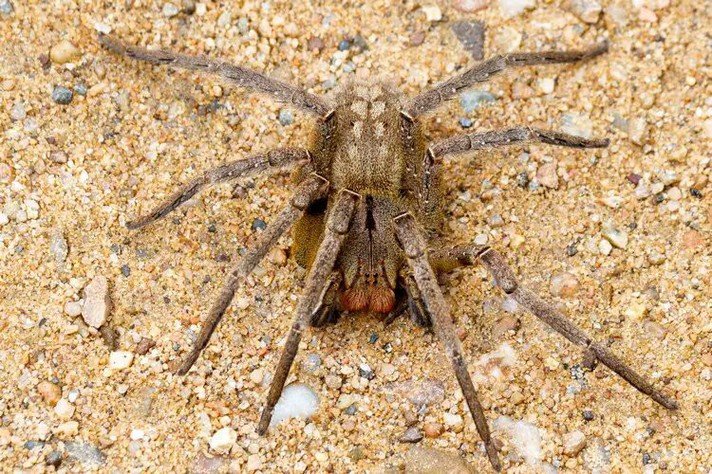
September 29, 2023
 Rodrigo Tetsuo Argenton/Creative Commons
Rodrigo Tetsuo Argenton/Creative Commons
Researchers in Brazil are testing a new erectile dysfunction treatment that uses venom from the Brazilian wandering spider.
For men, the venom of a South American spider may be the key to more fruitful sex life. Scientists in Brazil have been testing an alternative treatment for erectile dysfunction that uses venom from the Brazilian wandering spider, also known as a banana spider.
Their research isn't far-fetched. Venoms from snakes, lizards and spiders has been used for various medicinal purposes, including drugs used to treat high blood pressure, diabetes and heart attacks.
But why do scientists believe the Brazilian wandering spider, also known as the banana spider, can treat erectile dysfunction? The spider is one of the most venomous arachnids in the world. Their bites can cause a wide array of symptoms – including long, painful erections prompted by an increase in blood flow.
For nearly 20 years, researchers have been studying the use of its venom as potential erectile dysfunction therapy. Scientists have taken molecules in venom that are responsible for erections and used them to create a synthetic gel that can be applied to the penis.
The gel indeed caused erections when tested on lab rodents. The results of its initial clinical trial on humans, which sought to determine whether it causes any adverse side effect, suggest the gel is safe. The study also found the gel increases the blood flow of men and women.
"Tests, so far, have demonstrated that the compound works with the application of a minimum amount and without any toxicity, as it is practically not detected in the bloodstream," said Maria Elena, one of the Brazilian scientists that developed the treatment. "The big advantage is that the approval of topical medications tends to be much faster, due to the lower possibility of adverse side effects."
The researchers view the gel as an alternative treatment that can help the 30% of men with erectile dysfunction that cannot use current medications like Viagra or Cialis because they have other medical conditions. They also say it may help treat female sexual dysfunction – recurring issues with sexual response, desire, orgasm or pain.
The gel next will be tested on impotent men who have had their prostates removed because one of the risks of a prostatectomy is erectile dysfunction. But it also must pass a third phase of testing before it can receive regulatory approval and be placed on the market.
Impotence affects 15% of men worldwide, data from the World Health Organization shows. Around 40% of women have some sexual dysfunction, according to the Brazilian researchers.
Natural poisons are the basis for a number of effective medicines and others in development.
Captopril uses the venom of the Brazilian jararaca pit viper to reduce high blood pressure. Exenatide, which uses Gila monster venom, treats type 2 diabetes. The blood thinner integrilin, commonly given to heart attack patients, is derived from a protein found in the venom of the pygmy rattlesnake.
"Several hundred thousand heart attacks occur in the United States every year, and a significant proportion of these heart attacks are treated with agents, which unbeknownst to both the physician and patient, are actually derived from animal venom," Dr. Sandeep Nathan, director of the University of Chicago Medicine's Coronary Care Unit told CNN in 2020.
Snake venom is a "gold mine" for medicine due to its toxicity, biomedical scientist Zoltan Takacs told the news station. The toxins in the venom can be genetically engineered to form "mosaic toxins" that can be used to treat an array of medical conditions. At the the time, his research included using venom to target Parkinson's disease and cancer.
One promising drug still being tested uses venom from Australian Fraser Island funnel web spiders to stop the death of cells after a heart attack. Heart attacks reduce blood flow to the heart, making the heart cell environment more acidic – which kills cells. This drug blocks the cells' abilities to sense the acid, leading to improved heart cell survival.
Other venomous creatures have toxins that, though dangerous, may be the catalyst for medical discoveries, scientists say. They include the Komodo dragon, deathstalker scorpion and Northern short-tailed shrew.
The venom of Komodo dragons is unique in its delivery method. Instead of injecting venom through fangs, it oozes from sacks between the lizard's teeth. Its anticoagulant properties have the potential to treat conditions related to blood clots, such as strokes, heart attacks and pulmonary embolisms.
The deathstalker scorpion's venom contains a toxin called Chlorotoxin, which is being explored for use in diagnosing cancers and treating tumors.
The Northern short-tailed shrew is a rarity among mammals given its venom, but it's not potent enough to kill people. It is being studied as a potential cancer treatment because some tumor cells have molecules with a structure that is similar to the natural target of the shrew's toxin.